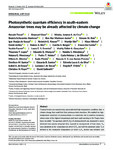Photosynthetic quantum efficiency in south‐eastern Amazonian trees may be already affected by climate change
| dc.contributor.author | Tiwari, R | |
| dc.contributor.author | Gloor, E | |
| dc.contributor.author | Cruz, WJA | |
| dc.contributor.author | Schwantes Marimon, B | |
| dc.contributor.author | Marimon‐Junior, BH | |
| dc.contributor.author | Reis, SM | |
| dc.contributor.author | Souza, IA | |
| dc.contributor.author | Krause, HG | |
| dc.contributor.author | Slot, M | |
| dc.contributor.author | Winter, K | |
| dc.contributor.author | Ashley, D | |
| dc.contributor.author | Béu, RG | |
| dc.contributor.author | Borges, CS | |
| dc.contributor.author | Da Cunha, M | |
| dc.contributor.author | Fauset, S | |
| dc.contributor.author | Ferreira, LDS | |
| dc.contributor.author | Gonçalves, MDA | |
| dc.contributor.author | Lopes, TT | |
| dc.contributor.author | Marques, EQ | |
| dc.contributor.author | Mendonça, NG | |
| dc.contributor.author | Mendonça, NG | |
| dc.contributor.author | Noleto, PT | |
| dc.contributor.author | Oliveira, CHL | |
| dc.contributor.author | Oliveira, MA | |
| dc.contributor.author | Pireda, S | |
| dc.contributor.author | Santos Prestes, NCC | |
| dc.contributor.author | Santos, DM | |
| dc.contributor.author | Santos, EB | |
| dc.contributor.author | Silva, ELS | |
| dc.contributor.author | Souza, IA | |
| dc.contributor.author | Souza, LJ | |
| dc.contributor.author | Vitória, AP | |
| dc.contributor.author | Foyer, CH | |
| dc.contributor.author | Galbraith, D | |
| dc.date.accessioned | 2020-05-27T08:39:12Z | |
| dc.date.issued | 2021-07 | |
| dc.identifier.issn | 0140-7791 | |
| dc.identifier.issn | 1365-3040 | |
| dc.identifier.other | pce.13770 | |
| dc.identifier.uri | http://hdl.handle.net/10026.1/15704 | |
| dc.description.abstract |
<jats:title>Abstract</jats:title><jats:p>Tropical forests are experiencing unprecedented high‐temperature conditions due to climate change that could limit their photosynthetic functions. We studied the high‐temperature sensitivity of photosynthesis in a rainforest site in southern Amazonia, where some of the highest temperatures and most rapid warming in the Tropics have been recorded. The quantum yield (<jats:italic>F</jats:italic><jats:sub><jats:italic>v</jats:italic></jats:sub>/<jats:italic>F</jats:italic><jats:sub><jats:italic>m</jats:italic></jats:sub>) of photosystem II was measured in seven dominant tree species using leaf discs exposed to varying levels of heat stress. <jats:italic>T</jats:italic><jats:sub>50</jats:sub> was calculated as the temperature at which <jats:italic>F</jats:italic><jats:sub><jats:italic>v</jats:italic></jats:sub>/<jats:italic>F</jats:italic><jats:sub><jats:italic>m</jats:italic></jats:sub> was half the maximum value. <jats:italic>T</jats:italic><jats:sub>5</jats:sub> is defined as the breakpoint temperature, at which <jats:italic>F</jats:italic><jats:sub><jats:italic>v</jats:italic></jats:sub>/<jats:italic>F</jats:italic><jats:sub><jats:italic>m</jats:italic></jats:sub> decline was initiated. Leaf thermotolerance in the rapidly warming southern Amazonia was the highest recorded for forest tree species globally. <jats:italic>T</jats:italic><jats:sub>50</jats:sub> and <jats:italic>T</jats:italic><jats:sub>5</jats:sub> varied between species, with one mid‐storey species, <jats:italic>Amaioua guianensis</jats:italic>, exhibiting particularly high <jats:italic>T</jats:italic><jats:sub>50</jats:sub> and <jats:italic>T</jats:italic><jats:sub>5</jats:sub> values. While the <jats:italic>T</jats:italic><jats:sub>50</jats:sub> values of the species sampled were several degrees above the maximum air temperatures experienced in southern Amazonia, the <jats:italic>T</jats:italic><jats:sub>5</jats:sub> values of several species are now exceeded under present‐day maximum air temperatures.</jats:p> | |
| dc.format.extent | 2428-2439 | |
| dc.format.medium | Print-Electronic | |
| dc.language | en | |
| dc.language.iso | en | |
| dc.publisher | Wiley | |
| dc.subject | Amazon forest | |
| dc.subject | high-temperature tolerance | |
| dc.subject | photosynthesis | |
| dc.subject | PSII maximum quantum yield | |
| dc.subject | tropical evergreen trees | |
| dc.title | Photosynthetic quantum efficiency in south‐eastern Amazonian trees may be already affected by climate change | |
| dc.type | journal-article | |
| dc.type | Journal Article | |
| dc.type | Research Support, Non-U.S. Gov't | |
| plymouth.author-url | https://www.webofscience.com/api/gateway?GWVersion=2&SrcApp=PARTNER_APP&SrcAuth=LinksAMR&KeyUT=WOS:000529301500001&DestLinkType=FullRecord&DestApp=ALL_WOS&UsrCustomerID=11bb513d99f797142bcfeffcc58ea008 | |
| plymouth.issue | 7 | |
| plymouth.volume | 44 | |
| plymouth.publication-status | Published | |
| plymouth.journal | Plant, Cell & Environment | |
| dc.identifier.doi | 10.1111/pce.13770 | |
| plymouth.organisational-group | /Plymouth | |
| plymouth.organisational-group | /Plymouth/Faculty of Science and Engineering | |
| plymouth.organisational-group | /Plymouth/Faculty of Science and Engineering/School of Geography, Earth and Environmental Sciences | |
| plymouth.organisational-group | /Plymouth/REF 2021 Researchers by UoA | |
| plymouth.organisational-group | /Plymouth/REF 2021 Researchers by UoA/UoA06 Agriculture, Veterinary and Food Science | |
| plymouth.organisational-group | /Plymouth/Users by role | |
| plymouth.organisational-group | /Plymouth/Users by role/Academics | |
| dc.publisher.place | United States | |
| dcterms.dateAccepted | 2020-03-28 | |
| dc.rights.embargodate | 2020-5-28 | |
| dc.identifier.eissn | 1365-3040 | |
| dc.rights.embargoperiod | Not known | |
| rioxxterms.versionofrecord | 10.1111/pce.13770 | |
| rioxxterms.licenseref.uri | http://www.rioxx.net/licenses/all-rights-reserved | |
| rioxxterms.type | Journal Article/Review |


